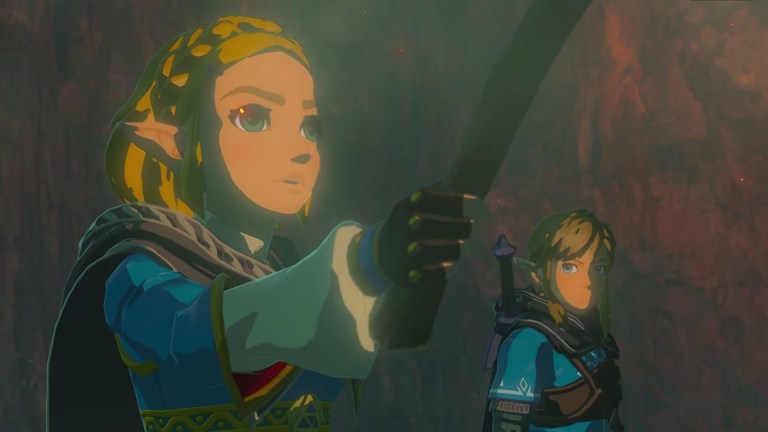Tears of the Kingdom’s Dungeons Are a Massive Disappointment
The long-awaited return of "traditional" Zelda dungeons in Tears of the Kingdom may have been overhyped.

This article contains spoilers for The Legend of Zelda: Tears of the Kingdom.
For as beloved and acclaimed as Breath of the Wild was, the game’s lack of traditional Legend of Zelda dungeons was a common and understandable criticism. While Breath of the Wild’s Shrines and Divine Beasts attempted to offer dungeon-like areas, neither came close to replicating that traditional Zelda dungeon experience fans craved.
However, fans remained hopeful that proper dungeons would reappear in Tears of the Kingdom. That hope only grew as early footage of the game showcased what appeared to be dungeon-like areas. Finally, in a recent interview, the Tears of the Kingdom team seemingly confirmed that “traditional “ dungeons were indeed a part of what was shaping up to be the biggest Zelda adventure yet.
Well, I can tell you that Tears of the Kingdom does feature something that comes much closer to classic Zelda dungeons. However, given the wording of what we were seemingly promised, it’s hard not to consider those dungeons a disappointment.
Putting semantics aside for a brief moment, there are essential six dungeons in Tears of the Kingdom: The Fire Temple, The Wind Temple, The Water Temple, The Lighting Temple, Hyrule Castle, and The Zonai Construct Factory/Spirit Temple. The final area of the game also features some dungeon-like qualities, but I suspect those six areas are what the team was referring to in that interview.
On the surface, those areas resemble classic Zelda dungeons. That is to say that they contain multiple floors, various puzzles, numerous enemies, a boss fight, and typically revolve around a particular ability. If you found yourself missing classic Zelda dungeons in Breath of the Wild, these new areas offer something closer to what you’re looking for.
However, their designs are actually quite different from the structures of classic Zelda dungeons. While each dungeon features certain gimmicks, most of them follow a pretty basic pattern that involves completing a set number of objectives. For instance, the Wind Temple asks you to restart five turbines, the Fire Temple sees you unlock five locks, and the Water Temple requires you to turn on four faucets.
With some slight exceptions, those objectives can usually be completed in any order. Each objective is typically found at the end of a path, and each of those paths is usually available to you at the start of the dungeon. While some of the challenges you find along those paths require you to use a special Sage ability that is unique to the dungeon, they typically feature different combat and puzzle-based obstacles. So, while the basics of that objective-based structure are a slight holdover from Breath of the Wild‘s Divine Beasts, Tears of the KIngdom‘s dungeons offer significantly more variety from path to path and from dungeon to dungeon.
To be clear, these dungeon areas can be a lot of fun. The Construct Factory/Spirit Temple, in particular, is filled with wonderful puzzles and quite a few narrative surprises. I also enjoyed some of the smaller sequences unique to each temple such as the minecart fights in the Fire Temple. More importantly, the boss fights that you find at the end of those dungeons feel closer to classic Zelda boss fights. I wouldn’t go so far as to say they rank high among the best Zelda boss fights ever, but the scale of these encounters and the way the bosses represent the themes of their environments instantly make them an obvious improvement over what we got in Breath of the Wild.
However, that’s the bar I keep running into. Yes, Tears of the Kingdom‘s dungeons are significantly better than what we got in Breath of the Wild. I can’t imagine the debate that would argue otherwise. However, it’s hard not to be a little disappointed in these dungeons given that we previously heard that they would be closer to the traditional dungeons fans asked for. Whatever these areas are, they are certainly not traditional Zelda dungeons, nor do they always recapture the magic of those dungeons in unique ways.
It’s incredibly unfortunate that Tears of the Kingdom’s dungeons still follow that “complete X objectives” format that Breath of the Wild’s Divine Beasts also utilized. Improvement aside, the fact of the matter is that the dungeons that follow that format end up feeling surprisingly linear. Your objectives are often found at the end of a set path, and those paths typically do not cross or interact with each other in meaningful ways. At times, it almost feels like you’re completing a series of Shrines rather than working your way through an elaborate structure.
It’s a far cry from the puzzle box design that many pre-Breath of the Wild Zelda dungeons utilized. Those dungeons were designed to offer numerous “Aha!” moments that you just don’t get with this new format. The Sage abilities that these dungeons grant you are also nowhere near as engaging as the special items previous Zelda dungeons were often built around. Those old items contributed to the almost Metroidvania-like layout of classic Zelda dungeons in ways that made them feel vital and significant. Sage abilities, in the context of dungeons, rarely feel like more than neat necessities that rarely contribute to creative solutions in the way that Link’s other abilities do.
It doesn’t help that most of Tears of the Kingdom’s dungeons are painfully easy. Whereas classic Zelda dungeons often involuntarily made you draw a deep breath in order to steel yourself for the challenges that lie ahead, you’ll soon find that there is little in Tears of the Kingdom’s dungeons that you aren’t adequately prepared for. For some reason, the game decides to put the kid’s gloves back on whenever you enter these areas. I can’t think of a dungeon puzzle, fight, or navigation mechanic that was more creative or challenging than what I found in the game’s open world.
And that’s the biggest problem with Tears of the Kingdom’s dungeons. Despite their improvements, they often pale in comparison to what the rest of the game has to offer in many of the same key areas. You’ll find significantly more challenging enemies in Tears of the Kingdom’s Depths than you will in the game’s dungeons. You’ll find more complex and engaging opportunities to explore the possibilities of the game’s core abilities out in the world than you will in dungeons. Even Tears of the Kingdom’s Shrines collectively offer more (and sometimes better) puzzles.
In a recent interview, Tears of the Kingdom director Hidemaro Fujibayashi talked about wanting to make the game’s dungeons feel like a “seamless” part of the world. The idea was that you could dive into or out of a dungeon as if it were any other part of the game’s world and that the dungeon experience wouldn’t pull you out of the rest of the game more than what is necessary.
It’s a nice idea on paper, but that seamless approach often makes these dungeons feel strangely commonplace. They have little to offer that can’t be found elsewhere, and few of them feature thematic concepts more complex or engaging than the elements many of them are named after. They are fairly well designed for what they are, but they rarely feel like the events they should feel like.
But if the problem is that so much of the rest of the Tears of the Kingdom experience can offer more than these dungeons can, then what’s the solution? Well, I think there are two likely solutions, and one of them is actually hinted at in the game.
I haven’t said much about Hyrule Castle yet, and that’s because I think it’s the one Tears of the Kingdom dungeon that offers something closer to an ideal modern Zelda dungeon experience. Though you can technically enter it from the start of the game (a neat feature), most players will encounter it towards the end of their journey. There, they will find a much less linear kind of scavenger hunt filled with hidden high-quality items, difficult combat challenges, and a few possible methods of progression/completion. There are still objectives, but they’re structured in a way that encourages you to consider the dungeon as an entire structure rather than a series of set paths.
Hyrule Castle feels closer to a culmination of what you’ve learned and experienced from the game up until that point. Even getting into the castle can be a complicated task that can be completed in various ways that are designed to put your creativity to the test. It’s not perfect, but it feels closer to a milestone marker of your progression in ways that the other Zelda dungeons simply do not.
It’s also the closest the game gets to offering my ideal modern open-world Zelda dungeon experience: the legacy dungeons from Elden Ring.
Elden Ring’s legacy dungeons were integrated into the game in ways that allowed you to feel as if you organically discovered them, but they were clearly designed to test the progress you’ve made so far. You were rewarded for completing the incredible challenges they offered with gear, abilities, and rewards that had a notable impact on how you played the rest of the game. Crucially, those dungeons also felt thematically and visually significant in terms of both the narrative and the structure of the world. That’s certainly true of major Elden Ring dungeons like Leyndell, Royal Capital, but even lesser dungeons such as Caria Manor felt like destinations that offered irreplaceable experiences rather than stops along the way.
However, Tears of the Kingdom’s dungeons might just be another piece of evidence for the increasingly popular argument that it’s time for Nintendo to splinter the Zelda franchise into two styles of releases: games like Breath of the Wild and Tears of the Kingdom and more traditional Zelda titles.
The latter types of games may end up being smaller, but that’s not necessarily a problem. I personally miss the “handheld” style of Zelda games, and the recent Link’s Awakening remake shows that those kinds of games can still feel substantial. Furthermore, if it’s going to take longer to develop games like Tears of the Kingdom (which is understandable), then it would be nice to receive smaller Zelda games in between those releases. Besides, those classic Zelda titles are still capable of offering a worthwhile experience that titles like Tears of the Kingdom can’t exactly replicate.
That’s ultimately what we’re talking about. Tears of the Kingdom is an absolutely brilliant game that represents a path forward for the Zelda franchise that Nintendo should follow. They can almost certainly improve Tears of the Kingdom‘s dungeons just as they improved upon Breath of the Wild‘s Divine Beasts, and I hope they will. Of course, I can’t ignore that Tears of the Kingdom has so much more to offer than its dungeons.
Yet, the facsimile of dungeons that we get in this otherwise brilliant game sometimes makes the absence of truly great Zelda dungeons strangely feel more substantial. I just hope that Nintendo, Zelda, and Tears of the Kingdom aren’t so quick to call these dungeons “good enough” or “close enough.” Wherever the Zelda franchise goes from here, better dungeons need to be a part of it.
